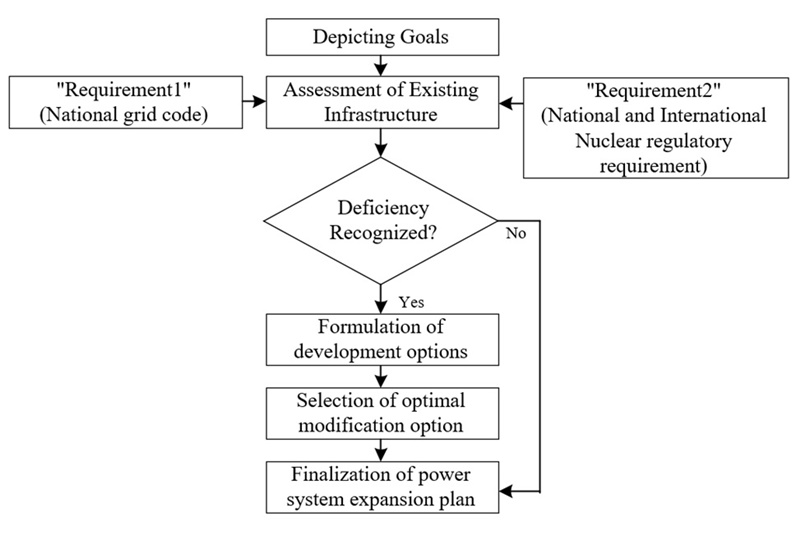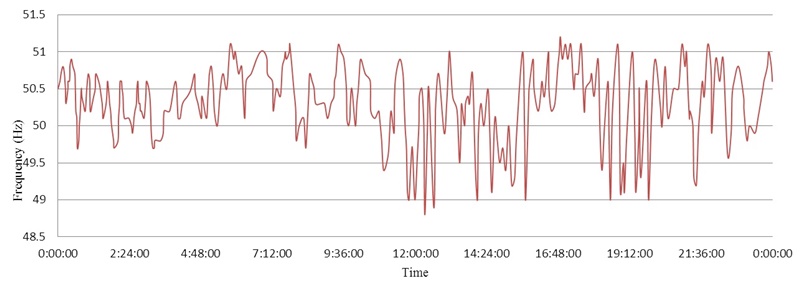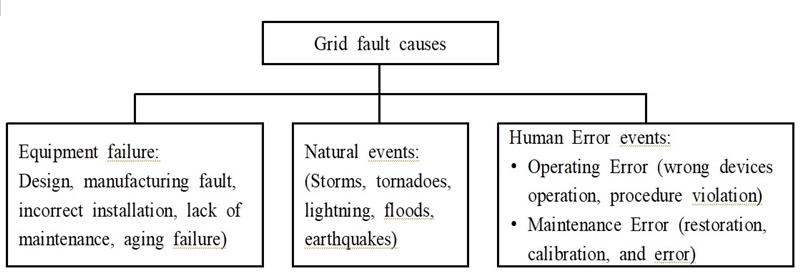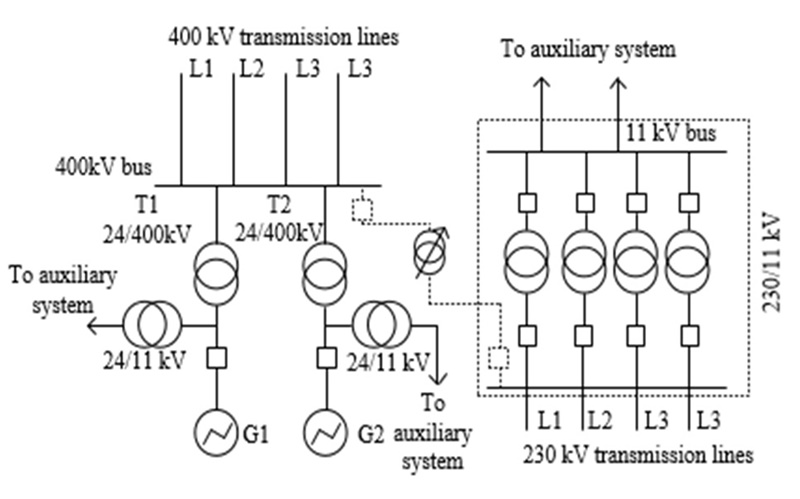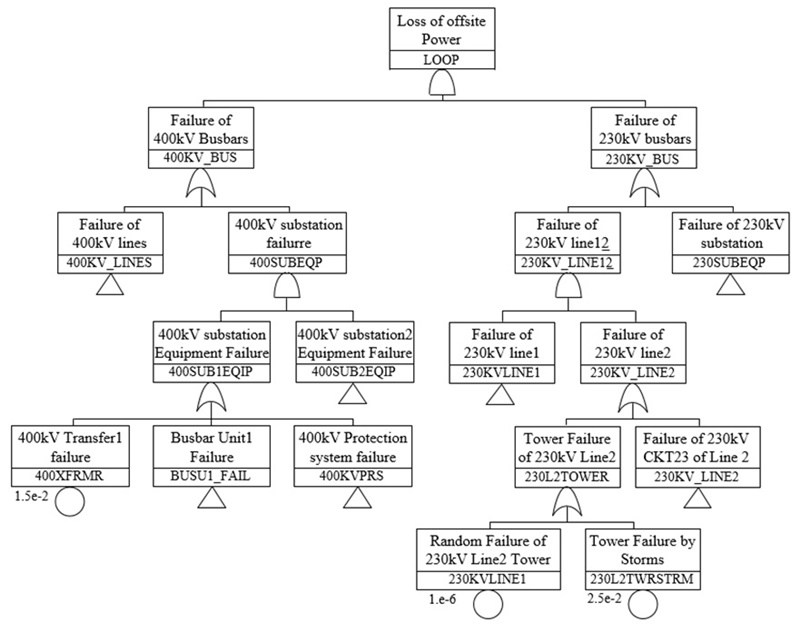
Assessment of the Electrical Grid System to Accommodate the First Nuclear Power Plant in Bangladesh
Abstract
Nuclear energy has been identified as an economical and environmentally clean source of electricity generation in Bangladesh. Nuclear power plants (NPP) are designed to serve as the base-load plant with a lower ramp rate of power change, stringent voltage and frequency margin. Moreover, the nuclear reactor needs a reliable long-term shutdown cooling that consumes huge electricity from the grid under strict voltage and frequency regulations. This paper addresses a modeling approach including the development of a fault-tree model for reliability evaluation of an electric grid system to accommodate an NPP. The analysis of the existing grid system in Bangladesh identified the areas of improvement in which the programs for grid frequency control, modifying governors of the operating plants and reduction of seasonal load variation are the most significant. This study also revealed that the development of a detailed fault tree model is essential to identify the most susceptible elements of the grid system and resources can be allocated accordingly to minimize the risk. The hindrances related to grid development are also discussed in this paper.
Keywords:
Grid reliability, Nuclear power plant safety, Fault tree, Frequency regulation1. Introduction
Access to reliable electrical energy at an affordable price is the key to industrial and economic progress. Nuclear power is a significant option for bulk clean electricity generation, and many countries are planning to include nuclear electricity to reduce carbon emissions. However, nuclear power project becomes challenging because they are highly capital-intensive compared to conventional power projects. The capital investment also includes the development of a safe and reliable electrical grid system to evacuate power from the facilities. Electrical power system planners and utility need to consider a set of grid characteristics and develop the grid system fitted for interfacing the NPP. These characteristics are not considered strictly for conventional power plants. A grid sub-station for NPP is designed to evacuate power during normal operation, and the station supplies back-feed power to the plant at emergency and shutdown conditions. According to US NRC requirements, both onsite and offsite electric power systems shall be designed to ensure the functionality of the structures, systems, and components important to safety.1) In an assessment of a power system, the origin of risk is the probabilistic behavior of the system failure. The reliability of a power supply system can be quantified by employing an effective risk assessment model.2) Nuclear power plants are safety-critical power industries; a reliable grid system is essential to maintain the safety and sustainable operation of the plants. The instability of the electric grid and the risk of an NPP are interrelated. The risk of an NPP increases with decreasing the grid stability.3) A low reliable grid elevates the risk level of nuclear power plants. The unavailability of the grid is termed as the loss of offsite power (LOOP), and the events represent a measurable fraction of the risk of a plant, which is essentially considered in probabilistic risk assessments of nuclear power plants. Reduction in the frequency of LOOP events reduces the challenges to plant safety systems. In turn, reducing the number of challenges to safety systems reduces the risk to the plant. In this paper, an approach for the assessment of an electricity transmission system is presented along with focusing on the key characteristics of an electric grid for accommodating the first nuclear power plant in a country. The study considers the grid system of Bangladesh, and will provide insight to the professionals of the energy and power system planning.
2. Model for evaluation of grid system
A systematic approach for assessing the existing grid structure is shown in Fig. 1. In this approach, the host country will figure out the major objectives of the national grid studies. The objectives should be reasonable and justified.
Requirements are set after chalking out the objectives. In this stage, the requirements are set based on the national and international technical guidelines, codes, protocol, standard operating procedures for interfacing and operating an NPP. Assessment of the existing grid system is performed gathering the data on the system planning, design, operation and maintenance, and failures, and then comparing them with the requirements. This study provides information on the areas of improvement necessary for accommodating the first NPP. The utility needs to analyze the shortcomings and sorting out the solutions to minimize the limitations. The objectives could be obtained in several ways. However, the optimal path without compromising the safety of the NPP should be selected. The identified shortcomings are reviewed and reassessed the paths until a satisfactory the expansion plan is finalized. The construction of two nuclear power units with a capacity of 1,200 MW each is under construction in Bangladesh. Evaluation of the electrical grid system in Bangladesh has been performed for accommodating the NPP units.
3. Assessment of grid system in Bangladesh
Electric grid characteristics are required to study in-depth to know the behavior of the electric grid for a forced shutdown of the largest generation unit like an NPP. The grid system of Bangladesh is evaluated based on the techno-normative requirements.
3.1 Evaluation of grid characteristics based on requirements
Selection of the capacity of a generating unit is very crucial for a small and medium capacity grid. As a rule of thumb, the largest size could be allowed up to one-tenth of the grid load.4) lthough the capital cost per unit capacity of a generator is lower for the larger size, but, the capacity is determined considering the demand growth, base-load of the system, seasonal variation of demand, and maintenance schedule. The peak load of the summer evening in 2019 was 12,893 MW against the forecasted demand of 15,206 MW. The winter peak and the lowest demands are about 9,000 MW and 5,500 MW, respectively. The long-term electricity demand for Bangladesh was forecasted in the power system master plan (PSMP-2010), national energy policy.5) But over the years the demand did not increase as per reference forecast. Presently, the total generation capacity of the grid is about 21 GW in which the major contributors are small gas and oil-fired power plants. A number of large and medium-size power generating units (e.g. nuclear, coal, and LPG based-power units) are under construction. NPP units are used to serve base load. Considering the generation capacity of the grid, the size of a 1,200 MW NPP unit can be accommodated. But, the winter base-load is much low compared to the NPP capacity which should be increased significantly for reliable operation of the grid.
Grid bias or stiffness is the amount of power of the grid required to change in system frequency by one hertz without reducing the load in the grid, which is measured in megawatt per hertz. The grid bias mainly depends on the frequency responsive load of the system and droop characteristics of the generators. The grid bias should be strong enough to keep the system frequency and voltage at NPP terminal within the acceptable limit. A grid with a stiffness of over 1,050 MW/Hz is suitable for integrating a medium-size nuclear power unit.4) The system frequency often fluctuates by ±1 Hz resulting in actuation of under frequency and over frequency relays. Recently a test of Bangladesh grid system with a free governor mode of operation identified the system bias of 22~25 MW/0.1Hz for the system demand 6,500~7,100 MW.6)
The spinning reserve of a grid system is the available reserved capacity to meet the demand when any generating unit trips. In case of forced shutdown of single or multiple units, initially, the stability of the power system is maintained by the inertia of the system during the first few cycles, and then primary reserve units respond in a few seconds (generally 3~30 seconds) to bring the frequency at the nominal range.7) Usually, the reserve margin is determined based on the capacity of the largest generating unit of a grid system. The size of an NPP unit should be selected considering the capability of creating required spinning reserves for restoring the system frequency if the NPP gets a forced outage [8]. Presently, the range of regular frequency variation in the power system in Bangladesh is wide (48.9~51.2 Hz), which becomes wider (48.7~51.5 Hz) under different contingencies due to the failure of influential elements. The range is required to be narrower for accommodating the NPPs. The permitted frequency range of nuclear power units is 49.5~50.5 Hz. Under different contingencies, the allowable under and over frequency states are not more than 30 minutes once in 10 years. Gas turbine plants are used for both primary and secondary frequency control. At present, about 8% (capacity) of the power plants are capable of primary frequency control in Bangladesh.
Reactive power in a grid system exists due to a phase displacement between voltage and current. It remains positive during the one-half cycle and negative during another half cycle on the AC waveform, causing an average power supply to zero.9) However, balanced reactive power demand and supply are indispensable to maintain power system stability, reliability, and quality of electrical power. Usually, a nuclear power unit is not designed to supply large reactive power. It is recommended to choose the location of the NPP near a power station with high availability for maintaining the voltage by supplying adequate reactive power.10) In Bangladesh, the main sources of reactive power are generators and capacitor banks. The utility purchases power from the generating plant with a power factor in the range between 0.8 and 0.85 to receive reactive power from the power stations. However, large generators are usually designed to operate with a power factor of around 0.9 lagging to 0.95 leading. In this case, the utility will need to have a balanced reactive power management plan to meet the demand.
A mechanism (with a combination of automatic and semi-automatic) for load management is required for the smooth operation of a grid. Load restoration and load shedding in an NPP integrated grid system need to be maintained strictly in accordance with the grid operational protocol to avoid transients. After a strong transient due to large load restoration or partial collapse of a grid, the system load requirements, the characteristics of the NPP and other generating units in operation should be taken into consideration.10) The frequency of forced shutdown of transmission and power generation units including blackout should be taken into account conservatively in power system risk analysis of an NPP. For instance, loss of offsite power (LOOP) is considered as an accident-initiating event, and the frequency of LOOP is conservatively assumed to be once per year in the PSA analysis. Thus, a protocol of the grid operation should be developed emphasizing the safety of nuclear power plants.
Presently, the range of regular frequency variation in power system in Bangladesh is wide (48.9~51.2 Hz), which becomes more wide (48.7~51.5 Hz) under different contingencies. System frequency of typical day is shown in Fig. 2. Nuclear power plant allows a narrow range of grid voltage and frequency changes. The normal range of grid frequency for NPP is 49.0~50.5 Hz with voltage 0.95~1.05 p.u. The national grid code of Bangladesh has a requirement of a normal frequency range of 49.5~50.5 Hz. Further variations of grid frequency at contingencies are allowed for a very limited time. The fluctuation of grid voltage and frequency, depending on the magnitude of disturbances, can cause scram of a reactor, which in turn increases the risk of NPP. The accident risk goes up with the increasing rate of shutdown, startup, and transients.11) The reactor trip occurs at a much higher rate due to the fluctuation of voltage and frequency compared to the offsite power loss. For instance, in the USA, over 50% of the scram-related events occurred due to some short-term grid disturbance (spikes) during 1993~2003.3) The fluctuation of grid frequency for a particular quantity of generation loss depends on the factors: total system load at tripping time, instantaneous dynamic inertia of the system produced by the units in operation, and the damping effect of load with frequency changes.12)
Clearing or isolating the faults, depending on the types and severity of faults, becomes important for maintaining the safety and stability of the system. Usually frequently occurring faults in overhead transmission lines are temporary. If any fault sustains more than 6~8 cycles (i.e. 0.12~0.16 sec.), the faulty part of the system is permanently isolated by automatic protective devices. Presently, the fault clearing time is 80 millisecond (ms), 100 ms, and 120 ms for 400 kV, 230 kV, and 132 kV, respectively.
3.2 Result
The electric grid of Bangladesh is assessed reflecting the IAEA guidelines, and a summary of the qualitative analysis through comparison between the existing grid system in Bangladesh and a high-performance grid is shown in Table 1.
4. Probabilistic risk analysis
A grid system needs to be assessed qualitatively and quantitatively to ensure the reliability of the system over the entire life cycle of an NPP. A probabilistic risk assessment (PRA) of a grid helps to identify the major causes and vulnerable points of the system for which necessary measures can be taken to improve the transmission system. A simple model for estimating the failure probability of a transmission system is shown in this section focusing on the causes of grid faults. The components of an electric grid system can fail mechanically or electrically putting the power system in a fail state. Severe weather and environmental conditions are identified as the leading cause of grid outages in different countries. For instance, extreme weather events were the principal contributor to the US power outages between 2000 and 2012.13) The natural and manmade causes of equipment failure should be considered in the PRA of a grid system. The major causes of grid faults are given in Fig. 3.
4.1 Estimation of unavailability of offsite power
A probabilistic model to estimate the failure probability of an electric grid system is presented in this section considering the different events- random failure of equipment, extreme weather events, floods, earthquakes, and human error. The unavailability of Offsite power to NPP substation to can be expressed as follows:
| (1) |
A simplified fault-tree model to estimate the loss of offsite power due to the unavailability of the power transmission is presented in this section. Generic data of hardware failure rates are considered for the fault tree model. To estimate the unavailability of offsite power due to the failure of the power transmission system (Fig. 4), a fault tree model is depicted in Fig. 5.
The elements of the power transmission systems-insulators, conductors, and towers can fail due to weather events and exposure to polluted environments. Besides, the high voltage insulators have their specific failure mechanism. The statistic shows that the failure rates of high voltage insulators and power transformer are 10-4 /unit-year14) and 4.7×10-4 /unit-year, respectively. The failures of power transformers occur due to major causes like poor design and materials, aging, pollution, are discussed by Vahidi et al.15) The instrument transformer failure rate and circuit breaker failure rates are 2×10-3 /unit-year and 3×10-4, respectively.
The inclusion of weather events in the reliability study of a grid system is significant. In Bangladesh, natural events are frequent and caused the whole grid system failure. The weather events are considered in the fault-tree model presented in this paper. Statistical data related to the cyclonic and summer storms over the past 50 years was analyzed. Usually, the grid structure in Bangladesh is designed against the maximum wind speed of 200 km/hr. for the structures in the coastal areas and 160 km/hr. in other areas. The frequency of lightning in Bangladesh is also very high. Electrical infrastructures in Bangladesh are designed assuming 80-thunderstorm days per year. Lightning causes failure of insulators, instrument transformers and lightning arresters.
Consideration of lightning flashes over power transmission lines is also important in fault-tree analysis. The fault-tree model presented in Fig. 5 is of the transmission systems shown in Fig. 4. The 230 kV system consists of a 230/11 kV substation and two 230 kV overhead double circuit transmission lines. On the other hand, the 400 kV transmission system consists of a 400/24 kV substation with four 400 kV overhead transmission lines. The unavailability of the offsite power due to the transmission system failure was estimated to 2.03×10-5 per year.
5. Discussion
This paper presents a modeling approach for the probabilistic safety assessment of electric grid system for interfacing the first nuclear power plant in a country. The following are important mentions from the study:
Availability of transmission lines depends on the structural design equipment reliability redundancy and protection plan against electrical faults. In this study the unavailability caused by the failure of the power evacuation system of NPP was estimated by the simplified fault-tree analysis. The estimated unavailability of the transmission system is 2.03×10-5 per year. A detailed fault-tree model development for the grid system is necessary to identify the vulnerable points of the grid and preparing plan to strengthen the reliability. Furthermore major transient rates should be estimated considering the whole grid system. The power evacuation system for NPP shall be much higher than the systems used in the conventional power plants because of the necessity of long operation of NPP auxiliary system even after shutdown of the reactors for the safe evacuation of the decay heat from the reactor. A large spinning reservoir shall be ensured before commencing the commercial operation of the nuclear power plant in Bangladesh. The NPP unit under construction will be very large compared to the operating plants in Bangladesh, so the primary and secondary spinning reserves should be increased to meet the requirements.
The grid bias of Bangladesh is found to be very poor compared to a high-performance grid. To strengthen the frequency stability the automatic governing system should be widely added to the presently operating plants, and the number of frequency responsive plants should be increased. In addition the demand in the system needs to increase. There is a scope to increase grid demand by about 20% by connecting the industrial captive loads to the grid which is currently powered by captive power plants.
Fault-tree modeling of the large plants would be also useful for improving the reliability of the grid system with consideration of the probability of the malicious activities for the probabilistic safety analysis of the power supply system. A grid failure can also occur due to human error in grid operation and maintenance tasks. The scope of human error incidence in maintenance and operation tasks is huge, which could occur through missing an important step of work procedure to intentional deviation of work procedure from the standard procedure.16,17) Thus the inclusion of human error probability in fault-tree analysis for grid systems will provide a better estimation.
6. Conclusion
The grid system in Bangladesh needs to be upgraded massively in different areas to accommodate two nuclear power units which are presently under construction. This study presents the scope of improvement of the power grid system. The identified major deficiencies of the existing grid system of Bangladesh are weak grid bias poor frequency regulation and high variation of seasonal demand. To improve the frequency regulation the automated governing systems to the old and new power plants including automated or semi-automated load management shall be incorporated. Although the unavailability estimated by the fault-tree model presented in this paper meets the requirement a detailed fault-tree model for the entire power transmission system should be developed for better estimation of the risk and justifying the resource allocation appropriately for reliability improvement. Reliability improvement of a power system is a continual process. This paper provides a means for reliability assessment of an electrical grid system intended to interface with a nuclear power plant and this study will be useful for conducting a rigorous safety assessment of a grid system.
Nomenclature
| QOP : | Resultant failure probability [-] |
| QRP : | unavailability of power sources [-] |
| QTP : | transmission system unavailability [-] |
Author contributions
M. Khalaquzzaman; Study conception and design, Collection of data, Analysis and interpretation of data, Drafting of manuscript, Critical revision, Md. Adil Chawdhury; Collection of data, Analysis and interpretation of data, Drafting of manuscript.
References
- US NRC, 2011, Appendix A to Part 50-General Design Criteria for Nuclear Power Plants, US NRC 10CFR.
-
L. Guo, Q. Qiu, J. Liu, Y. Zhou and L. Jiang, 2014, "Power transmission risk assessment considering component condition", Journal of Modern Power Systems and Clean Energy, Vol. 2, No. 1, pp. 50-58.
[https://doi.org/10.1007/s40565-013-0042-y]

-
B. Kirby, J. Kueck, H. Leake and M. Muhlheim, 2007, "Nuclear Generating Stations and Transmission Grid Reliability", 39th North American Power Symposium, pp. 279-287.
[https://doi.org/10.1109/NAPS.2007.4402323]

- IAEA, 2012, Electric Grid Reliability and Interface with Nuclear Power Plants, IAEA nuclear energy series No. NG-T-3.8.
- M. Khalaquzzaman and J. H. Kim, 2008, "Long-term sustainable energy supply and mitigation of greenhouse gas emission in Bangladesh", International Energy Journal, Vol. 9, No. 2, pp. 89-98.
-
M. A. Chawdhury and D. Chattopadhyay, 2018 "A New Beginning in Frequency Control for the Bangladesh Power System", IEEE Power & Energy Society General Meeting, pp. 1-5.
[https://doi.org/10.1109/PESGM.2018.8586572]

- C. Hultholm and N. Wägar, 2015, "Optimal reserve operation in Turkey – frequency control and non-spinning reserves", Power-Gen Europe 2015.
- IAEA, 1987, "Introducing nuclear power plants into electrical power system of limited capacity: problem and remedial measures", Technical Report Series, No. 271.
- K. L. Anaya and M. G. Pollitt, 2018, "Reactive Power Management and Procurement Mechanisms: Lessons for the Power Potential Project", Energy Policy Research Group, University of Cambridge 11th.
- IAEA, 1983, "Interaction of grid characteristics with design and performance of nuclear power plants", Technical Reports Series, No. 224.
-
M. Khalaquzzaman, H. G. Kang, M. C. Kim and P. H. Seong, 2011, "Optimization of periodic testing frequency of a reactor protection system based on a risk-cost model and public risk perception", Nuclear Engineering and Design, Vol. 241, No. 5, pp. 1538-1547.
[https://doi.org/10.1016/j.nucengdes.2011.02.003]

- B. A. Allaf, 2010, "Practical evaluation of frequency response and bias in electrical power systems", Proc. of the 8th regional conference for national committees of CIGRE in the Arab countries and 15th Exhibition for electrical equipment, 18-20, p. 64.
-
R. A. D. Melissa, K. C. Binita and I. C. Colin, 2019, "Extreme Weather and Climate Vulnerabilities of the Electric Grid : A Summary of Environmental Sensitivity Quantification Methods", Oak Ridge National Lab.
[https://doi.org/10.2172/1558514]

- W. L. Vosloo and R. E, Macey and C.de. Tourreil, 2004, "A practical guide to outdoor high voltage insulators", Crown Publications.
- F. Vahid and S. Tenbohlen, 2014, "Statistical Failure Analysis of European Substation Transformers", Conference Proceedings, ETG-Fachtagung Diagnostik elektrischer Betriebsmittel.
- S. Mason, 2001, "Improving maintenance – reducing human error", In: Rail Safety, International Railway Engineering Conference. IMECHE Conference Transactions, C580/117/2000.
-
M. Khalaquzzaman, H. G. Kang, M. C. Kim and P. H. Seong, 2010, "A model for estimation of reactor spurious shutdown rate considering maintenance human errors in reactor protection system of nuclear power plants", Nuclear Engineering and Design, Vol. 240, Issue 10.
[https://doi.org/10.1016/j.nucengdes.2010.05.031]


